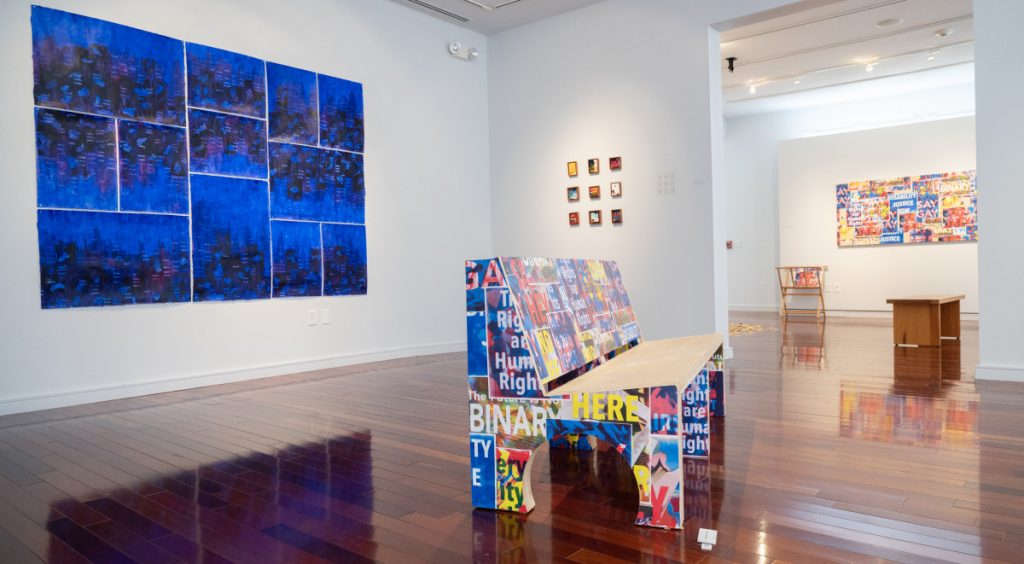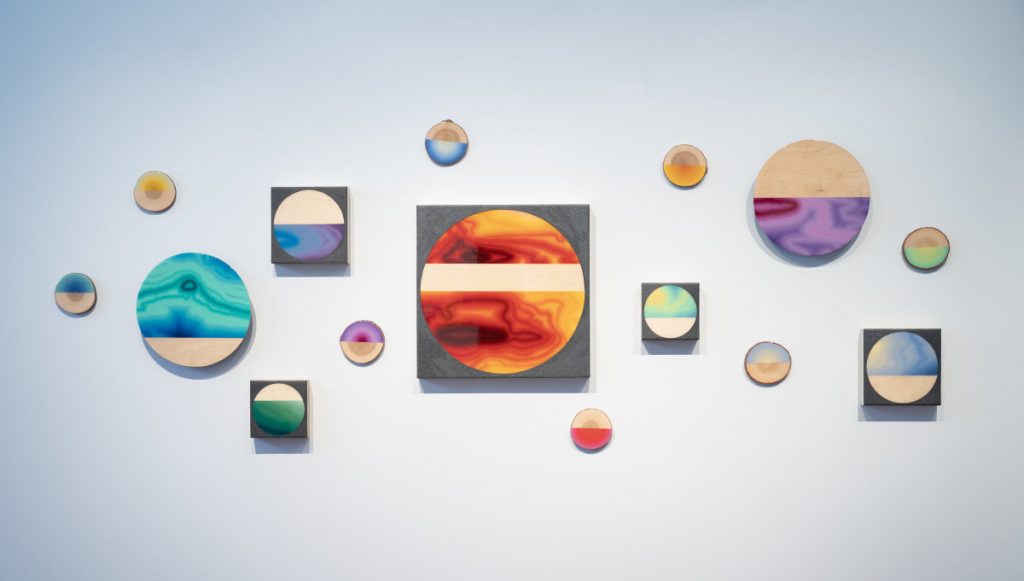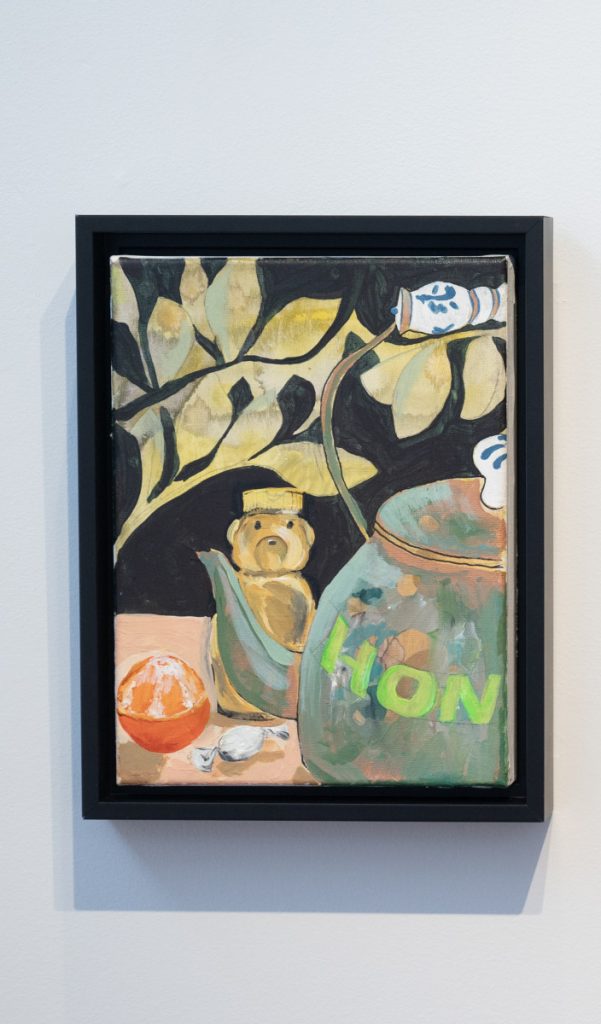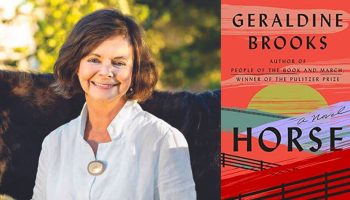
Julia Weber
Staff writer
With programming on pause this summer in Chautauqua Visual Arts, the department is looking to alumni for inspiration.
CVA Alumni celebrate the theme “Positive Change” through a collection of pieces created by former students and interns in the program.
Curated by Associate Director of CVA Galleries Erika Diamond, the exhibition aims to uplift the work of emerging artists who have been involved with Chautauqua’s visual arts community. The collection of work is on view through Sunday on the second floor of Fowler-Kellogg Art Center.
The exhibition spans three rooms and serves as a testament to the breadth of medium, theme and technique fostered by the visual arts program. Upon entering the exhibition, viewers are first greeted by Lara Mann’s colorful interstellar hanging works and Molly Bernstein’s ceramic pieces.
Bernstein’s organic ceramic vessels are light, colorful and reminiscent of childhood. Both in theme and in technique, the forms center playfulness.

“The playful nature of the surface mimics the way the pots were constructed using a simple coil pinch method frequently taught in elementary school art classes,” Bernstein wrote in her description.
Mann, who has always been fascinated by space and the universe, found inspiration for her pieces in the James Webb Space Telescope. Her “meditative” “Orbit” series uses slowly shifting gradients to trace wood grain in her pieces, Mann creates otherworldly works of art that reflect nature both lightyears away from us and rooted in the Earth itself.
Mann was an intern with Chautauqua Visual Arts when she was an undergraduate student in college, and she credited her time here as being foundational in her understanding of gallery work and the art industry.
“Chautauqua has a very special place in my heart because it’s an amazing place,” she said. “But, also the people there — they actually care about everyone and everything and that is a solid community.”
Tate Leon’s paintings evoke a sense of nostalgia and longing, even if you can’t quite put a finger on what it is longing for. Loose but intentional brushwork and objects from Leon’s memory conjure scenes from the artist’s past.
Two pieces specifically reference the “Sound of Music,” as Leon reflects on watching the movie as a child and how those memories have stayed with him.

Timothy Lee’s immensely precise watercolor works situated in the gallery navigate immigration and identity through a process of repetition and careful attention to detail.
“I’ve always seen abstraction as reality, codified; when we try to make sense of feelings, emotions, sensations – the human experience – that cannot exist in the realm of representation, abstraction allows artists to imbue forms, shapes and compositions with meaning to translate humanness into a language,” Lee wrote in his description.
Marshall Ransfield’s installation pieces explore notions of identity – identity as a transgender person, identity as a Jewish person and identity as a Maori person – primarily through textiles.
“A lot of what I unpack is, ‘What are these tools that I use to change what I express myself through?,’ or, ‘What is it that I’ve seen people perceive myself or others differently because of?’ ” Ransfield said.
Ransfield previously was an artist-in-residence at CVA, and highlights the intergenerational nature and diverse group of artists as a tremendous asset of the residency.

“There’s just something incredible about it,” Ransfield said.
Dispersed throughout the gallery are Kelsie Tyson’s handbuilt ceramic plates, which sport messages about social justice and emotional vulnerability.
Bright, vibrant tones in luster glazes paired with earthenware and stoneware forms bring a welcoming, approachable nature to the vessels, inviting viewers to have a conversation with the pieces and think deeply about the commentary Tyson is offering.
Jessica Valoris’ “micro paintings” line a wall of the gallery, composed of found objects, paint, thread and cardboard. Close by, a video titled “Rememories of Blue Mash” plays for viewers in the gallery.
“Dysfluency,” a much larger installation than the micro paintings series, is situated on a nearby wall. Vastly different in regard to medium and material, all of Valoris’ work focuses on Black liberation and racial identity.
Mic Diño Boekelmann’s manila envelope installations are an ode to her mother’s heritage in the Philippines. Boekelmann is also a former artist-in-residence and she credits her time in Chautauqua as a very fruitful experience.
Abaca, which is grown in the Philippines, was used originally to make manila envelopes. For Boekelmann, using these envelopes in her work is a way of reconnecting with her heritage and documenting her ancestry.
She hopes that viewers take away an understanding of interconnectedness in her work and in the exhibition.

“In all of (my pieces), you’ll see these connectors connecting jasmine flowers to the figure, so that’s the bigger theme of interconnectedness, and connection between ourselves – to each other and to nature,” she said.
Toward the middle and back of the gallery, Brett Taylor’s prints immediately draw viewers’ attention. Taylor’s “Say It Loud, Say It Proud” triptych sparks a conversation surrounding social justice, inviting viewers into a dialogue about the intersection of art and advocacy.
A bench facing Ransfield’s installation piece continues the same conversation, adorned with screen printed phrases including “Say Gay,” “Trans Rights are Human Rights” and “My Body is Out for Repairs.” Taylor’s work as a screen printer focuses on promoting messages of social justice. Taylor is conscious of accessibility in museum and gallery spaces, and their work often incorporates accessibility measures like seating into exhibitions.
Colleen Coleman’s work is also quite varied in medium – she works in collage, encaustic and mixed media – but her work has another common theme throughout the pieces: What does it mean to be human?
“I’m hoping that I can bring a sense of humanity to the work that I create by educating people about difference, about things that they don’t understand, by being a catalyst for emotion,” the former artist-in-residence said.
While the work throughout the exhibition is varied in terms of medium, theme and content, all of the artists in the collection have one thing in common: a sense of connection with Chautauqua.
Coleman felt that Chautauqua was formative in her artistic journey.
“It was a real learning experience for all of us,” she said. “I feel really excited to still have close relationships with people that I met (in Chautauqua).”





